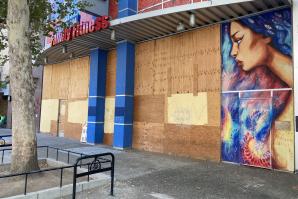It only takes a trip to the corner gas station to see firsthand what the headlines are telling us about inflation. Of course, we always expect gas prices to go up during the summer driving season. It’s as predictable every year as a 100-degree day at the California State Fair. But this year, record gas prices are a barometer of a much bigger problem. The latest U.S. Labor Department reports show that the price of everything is going up at a record pace. Inflation — the cost of goods and services compared to a year ago — is now over 9 percent, the highest it’s been in nearly 40 years. A big reason is the cost of energy, which increased significantly in the past year. Since almost everything we eat, wear or use is delivered by trucks, airplanes and ships that rely on oil, a price increase that large has a ripple effect across the whole economy.
But the biggest reasons for the jump in energy prices and the rise of inflation worldwide are far more complicated than the price at the gas pump. Droughts, floods and war are shaping, making and breaking markets. As products move around the world — and manufacturing involves processing in many different countries — local businesses, from farmers to small entrepreneurs, often are small pieces of a larger global economic jigsaw puzzle.
In this issue, our story “Seeds of Conflict” follows the connections between those bright yellow acres of sunflowers along Interstate 80 and the war-ravaged fields of Ukraine. Some of us see them as a picturesque photo opportunity, but they are actually a factory of sorts, producing hybrid sunflower seeds to be planted by farmers in Ukraine and other countries to produce cooking oil sold throughout the world. But many Ukrainian fields are fallow and under attack in a war, reducing the country’s sunflower production by 40 percent and reducing the need for seeds from Yolo County farmers. By contrast, as the war has slowed exports of wheat from Russia and Ukraine, two of the world’s largest producers, wheat farmers in the Capital Region and other parts of the country have seen the price of their crop double.
At the same time, a stagnant economy in China, hobbled by COVID-related shutdowns that continue in some of its biggest cities, has stifled manufacturing. Flooding in some of its biggest ports has created shipping bottlenecks that have broken down supply chains and produced inventory shortages for business. As you can read in our Special Section on construction, China’s pain is, to some extent, our region’s gain.
Demand for industrial and manufacturing space has grown, expanding development at Metro Air Park, McClellan and Mather to double normal levels, as distribution companies look to hedge against shortages by stockpiling material domestically, a practice known as “nearshoring.” As one developer told us, distribution companies have traded “just in time” inventory management for “just in case.” And in this case, it’s to the Capital Region’s benefit.
These stories underscore how intertwined local and international markets are in a global economy. Disruptions come with a price, whether it be a disappointed customer, a lost market share, or high costs — inflation — when supply and demand are out of balance.
But just as every action sparks a reaction, so too do events on one side of the globe have the potential to create both setbacks and opportunity on the other side. Growers, for instance, can reduce the acres they devote to sunflowers to better control their costs. Builders facing a 40 percent increase in lumber prices might find a substitute material or decide to change their designs.
It’s a reminder that the marketplace is always dynamic, constantly offering challenges and opportunities, whether for a large company or a smaller entrepreneur.
In a survey of 1,199 entrepreneurs released in June by SCORE, a mentoring organization for small business, 93 percent said they were concerned about inflation, outranking concerns about taxes and government regulation. And 34 percent said it was the single biggest problem facing their business.
But on the bright side, the SCORE survey showed that entrepreneurs are not letting inflation slow them down. Fifty-one percent reported that they had made recent capital investments to buy new equipment, new vehicles or to expand their facilities, despite increases in costs. In short, inflation is a lot like the weather. We are all affected by it, we all talk about it, and most of us can’t control it any more than we can curb drought, floods or war. It’s simply part of the landscape that businesses learn to navigate to remain successful.
Winnie Comstock-Carlson
President and Publisher
–
Stay up to date on business in the Capital Region: Subscribe to the Comstock’s newsletter today.
Recommended For You

Young People Are Our Future Community Leaders
Younger generations are rising to leadership positions as older people edge out of the workforce. To introduce the 2022 Young Professionals issue, Comstock’s president and publisher reflects on what makes these generations unique, and perhaps more importantly, what they have in common.

Looking for Potential in 2022
Setbacks aren’t the exception, they’re the rule. Comstock’s president and publisher reflects on the challenges faced not only during the pandemic, but throughout a lifetime, and considers how they’ve strengthened her outlook.

A Time for Contemplation — and Innovation
Comstock’s outgoing editor considers the Great Resignation and the ways the pandemic has reshaped how the world sees work.

The Next Act
Part 6 of our ongoing series on downtown Sacramento businesses dealing with COVID-19
Sacramento businesses continue to adapt and recalculate as COVID-19 evolves.

How the City Faced a Pandemic While Continuing to Grow
During her tenure as Sacramento councilwoman and mayor pro tempore, Angelique Ashby has played a role in some major developments for the city.





